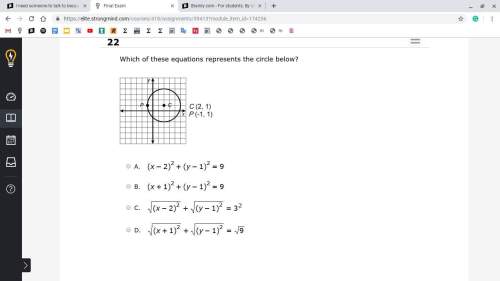
Mathematics, 19.12.2019 06:31, kkneedz1369
jeff has recorded the cost of insurance premiums on his car for a particular insurance company.
years payments
1 $1,200
6 $7,200
9 $10,800
daniel pays $1,150 per year for insurance premiums on his car. whose unit rate is lower in terms of cost per year, and what is the rate?

Answers: 3
Other questions on the subject: Mathematics

Mathematics, 21.06.2019 15:30, jakobrobinette
In δabc, if the length of side b is 3 centimeters and the measures of ∠b and ∠c are 45° and 60°, respectively, what is the length of side c to two decimal places?
Answers: 1

Mathematics, 21.06.2019 16:30, joThompson
You are cycling around europe with friends. you book into a hostel and you ask the owner what the ratio of men to women is currently staying there. there are 24 men and 6 women. what is the ratio of men to women in its simplest form?
Answers: 2

Mathematics, 21.06.2019 16:30, catdog2230
Determine whether the quadrilateral below is a parallelogram. justify/explain your answer (this means back it up! give specific information that supports your decision. writing just "yes" or "no" will result in no credit.)
Answers: 2

Mathematics, 21.06.2019 17:00, SillyEve
In tossing one coin 10 times, what are your chances for tossing a head? a tail? 2. in tossing one coin 100 times, what are your chances for tossing a head? a tail? 3. in tossing one coin 200 times, what are your chances for tossing a head? a tail? deviation = ((absolute value of the difference between expected heads and observed heads) + (absolute value of the difference between expected tails and observed tails)) divided by total number of tosses. this value should always be positive. 4. what is the deviation for 10 tosses? 5. what is the deviation for the 100 tosses? 6. what is the deviation for 200 tosses? 7. how does increasing the total number of coin tosses from 10 to 100 affect the deviation? 8. how does increasing the total number of tosses from 100 to 200 affect the deviation? 9. what two important probability principles were established in this exercise? 10. the percent of occurrence is the obtained results divided by the total tosses and multiplied by 100%. toss the coins 100 times and record your results. calculate the percent occurrence for each combination. percent head-head occurrence: percent tail-tail occurrence: percent head-tail occurrence:
Answers: 3
Do you know the correct answer?
jeff has recorded the cost of insurance premiums on his car for a particular insurance company.
Questions in other subjects:


Mathematics, 20.02.2020 23:04





English, 20.02.2020 23:04










